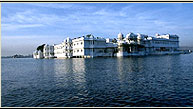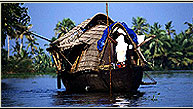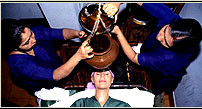-| Kanheri Caves | -
Location: District Mumbai - Lat 19º 13' N, Long 72º 59' E

The Kanheri caves lie in a wild picturesque valley in the heart of former islands
of Salsete, about 10 kms. west of Thane and 32 kms. north of Mumbai and about
8 kms. away from Boriwali suburban railway station.
The caves (120 in number) are situated in Sanjay National Park, a reserved forest.
The site of the caves is set apart, picturesque and can be distinguished from
the other hill, as it is barren.The top of these caves provide a spectacular
view of the whole Salesette island (Bombay) right up to the Vasai creck. This
is one of the largest Budhist establishements found in Western India. Being
on an ancient trade route between Kalayan and Sopara, this place also served
as resting place for the travellars, thus receiving great mercantile patronage.
The Kanheri caves were excavated from 1st century BC to 6th century AD. Most
of these were Buddhist viharas and chaityas. The sculptures at Kanheri are very
useful in the study of Buddhist art and iconography as it had witnessed continous
development of styles and features right from the early period when Buddhist
sculptores were introduced in this part of the country. The earliest sculptures
found here are those of Satavahana period and are comparable with similar contemparory
carvings at other Western Buddhist centres like Karla and Bhaja etc. Many colossal
images of Buddha are also found in the subsequent period. The Vajrayanic influences
can be noticed in the images of still later period i.e. in the unique figure
of eleven headed Avalokiteshvara.
Kanheri is the only settlement of western India which flourished for more than
ten centuries and has influence of three sects of Buddhist development. It was
more than a religion monastic dwelling. It was a self sufficient city having
its own prayer halls, lecture halls, a granery, water tanks and a cemetery.
All these suggest that it was an important, flourishing establishement of its
time.
The most significant aspect of the caves is the eloborate and intricate water
storage system. Small stream water ducts were caved into the rock surfaces at
right angles to allow water to percolate into concealed ducts than drove fresh
rain water into underground cistern tp preserve rainwater for the rest of the
year.
The caves signify the end of Hinayama and the beginning of the Mahayana period
thereby increasing their intrinsic value.




